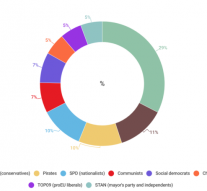
V4 group after Czech Republic’s election
Employment and Social Affairs 31 October 2017Czech Republic politics could shift more on the “hard side” of Visegrad group (Hungary, Poland, Czech Republic and Slovakia – the so called V4). It is a possible outcome of the Czech parliamentary elections held on 20 and 21 October, with ANO Movement – led by the entrepreneur and former Finance ministry Andrej Babis – emerging as the largest party in the central European country. Although Babis said that he will not form a government coalition together with far rights and other pro Russia parties, the country’s political outlook now seems to have more similarities to its two central European neighbors: Hungary and Poland.
Both Poland and Hungary have come into conflict with the EU’s institutions in recent years, namely on migration policy and human rights standards, while the social democrats leading in Czech Republic and Slovakia during those years had a kind of containment role between V4 hard core and the rest of the EU. Now after 21th October elections, in Prague social democrats (Cssd) have been reduced to just 15 seats in the Parliament. And that highlight that they could lose their role of pro-EU force able to close the widening gap between the hard side of V4 group and the rest of the EU. This scenario could be more and more realistic if, as it seems, Babis will form the new government deciding to support Czech President Milos Zeman attempt to be re-elected as head of State in upcoming presidential election on 2018.
In this framework, Slovak prime minister Robert Fico said, after the elections in its neighboring country, that Slovakia is “a pro-European island in its region”. The Slovak prime minister has also criticised the V4 political line as “dominated by the Hungarian and Polish right”. But Bratislava risks to be reduced to a marginal role if there will be a strong coordination among all the other leaders in the region. Furthermore the success of Sebastian Kurz in Austria and a future coalition with the far-right, with the new ambition to lead in the region together with V4, could really be an element threatening the EU in the area. The current Christian Democrat leader Kurz, is indeed in favor of delaying further integration of central and eastern European countries and he opposes the adoption of the euro currency by new EU members. But on the other hand could see at the interest for Austria in enhancing cooperation with the V4 also through a strong stance in the dialogue with Brussels.
All those trends, could be further enhanced by the fact that the region is one of the fastest growing area in all the EU. For example, as regard Czech Republic’s unemployment rate it was a mere 2.9% in June 2017, compared with 3.8% in Germany and 7.7% in the EU. That is due to several reasons: as cheap cost of labour, with the average hourly labor cost in the Czech Republic that in 2016 was just €10.20 ($12.07), well below the EU average. And the central European country’s manufacturing industry accounts the largest proportion of its economy compared with others in the EU, representing more than a third of all employment. And the production of cars, by companies like Toyota, Peugeot, Citroën, Škoda, and Hyundai, is now another crucial asset in the Czech economy. But is generally Central Europe’s economy that has been continuing a rapid expansion: according to this summer data, Romania grew by 5.7 per cent year on year in the second quarter; Czech Republic grew by 4.5 per cent; Poland by 4.4 per cent; Hungary by 3.6 per cent and Slovakia by 3.1 per cent. All this while the EU grew by 2.3 per cent.
Despite different positions for examples as regards migrant, it would be better for the UE to perceive a strong V4 not as challenge but as an opportunity. Their positive economic growth trend is indeed a success for all the EU project. And Brussels, while should keep on asking for more burden sharing on migration policy and on sticking to human rights and democracy standard, should also respect Hungary or Poland policy. It is not in the EU interest to create further divisions within the Union, also considering the key role V4 have for example to connect the EU from and infrastructure and economic point of view.
Since several years, Poland declared it has placed particular emphasis on infrastructural development within the region and cross-regional cooperation. And in recent years, territorial cohesion has become an key element of EU policy: trans-European networks are aimed at supporting the development of internal markets and at increasing economic and social cohesion within the EU. More specifically, V4 countries are responsible for developing connections between the Adriatic, Baltic and Black seas. Most of the infrastructure options for Romania and Bulgaria go through the V4 countries, and Poland remains the main land link which the Baltic States have with the rest of the EU.
Furthermore this summer Warsaw hosted the summit of “Three Seas Initiative”, promoted together from Poland and Croatia. Also US president Donald Trump attended this important summit, aimed at connecting three Sea in central Europa: Baltic, Adriatic, and Black sea. Thus strengthening the cooperation between this three key areas in Europe will lead to economic benefit for all the EU, also by streamlining a more positive role for new countries in the EU that will even contribute to keep alive the enlargement process.




